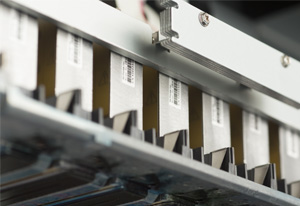Printhead engineering
Printheads have a direct effect on the speed of a wide-format inkjet printer, which in turn relates directly to the profitability of the sign business. If a sign shop is producing output at 11.1 m2 (120 sf) per hour, for example, and could upgrade its printer to produce output of the same or better quality at 32.5 m2 (350 sf) per hour at similar cost, then it could become nearly three times more profitable.
Each printhead features hundreds of nozzles that can fire ink onto the substrate. There are several types in today’s digital wide-format inkjet printers, including thermal drop-on-demand, piezoelectric drop-on-demand and continuous inkjet (CIJ) printheads.
Thermal printheads are used in durable aqueous ‘latex’ printers. As their name suggests, they heat ink. Once the ink is heated, it ‘explodes’ and generates tiny droplets.
Piezoelectric printheads are used in eco-solvent and UV-curing printers and are so named because they contain a piezoelectric material (i.e. one that changes mechanically in response to an electric charge) within an ink-filled chamber behind each nozzle. Specifically, when a certain voltage is applied to the material, it changes shape so as to generate pressure on the fluid, forcing a droplet of ink to fire from the nozzle.

The engineering and programming of the printheads will be key in ensuring a printer can properly fire ink onto the substrate.
With CIJ printheads, a high-pressure pump directs the liquid ink out from a reservoir and onto the substrate, also using a piezoelectric material to break the ink up into droplets. Only some of the droplets are needed for actual printing; most are instead recycled within the machine.
Thermal printheads have a very simple structure compared to piezoelectric models, which makes them less expensive. They are also more frequently replaced. Another difference is there is no advantage in terms of speed when running thermal printheads at lower-resolution settings.
Industrial piezoelectric printheads are designed to achieve higher speeds, maintain better reliability and jet higher-viscosity inks. While they are more expensive, their longer life means they can help reduce running costs significantly, as they do not need to be replaced as frequently. This in turn can increase profits per square foot of output.
CIJ printheads can achieve very high printing speeds and their nozzles do not get clogged, as the jets are always operating. Solvent can evaporate while the drops are ‘in flight’ (i.e. after they are ejected from the nozzles and before most are recycled), so it is important to monitor ink viscosity and add more solvent to the reservoir as needed.
Most types of wide-format inkjet printheads now use some type of multi-drop or variable-drop technology to enable smaller droplets for printing fine details and larger ones at other times in the interest of speed. Some use multi-pass printing to eliminate banding (i.e. unwanted lines) by randomizing dot placement in optimized modes and across various substrates. And others are designed to compensate for any clogged nozzles, which helps keep printhead replacement costs and printer downtime at a minimum.






